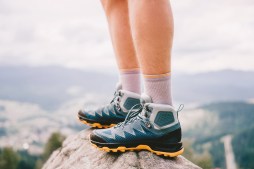Choosing the Right Gear for Your First Rock Climbing Adventure
Rock climbing is an exhilarating sport that combines physical strength, mental focus, and a love for the great outdoors. If you’re eager to embark on your first rock climbing adventure, it’s important to have the right gear to ensure your safety and enjoyment. In this article, we will guide you through the process of choosing the essential gear you need to get started with rock climbing.
I. Climbing Shoes: The Foundation of Your Gear
One of the most crucial pieces of gear for any rock climber is a good pair of climbing shoes. These specialized shoes are designed to provide maximum grip and support on various types of rock surfaces. When selecting climbing shoes, it’s important to consider factors such as fit, comfort, and durability.

Fit is perhaps the most critical aspect when choosing climbing shoes. It’s important that your shoes fit snugly without causing discomfort or pain. This ensures that you have optimal control over your footwork while climbing. Additionally, look for shoes with a slightly downturned shape as this helps with precision and stability on small footholds.
II. Harness: Keeping You Safe and Secure
A harness is another essential piece of equipment that every rock climber needs. This crucial item secures you to the rope system and protects you in case of a fall. When choosing a harness, comfort should be your top priority.
Look for a harness with adjustable leg loops and waistbelt so that you can customize it to fit your body shape perfectly. Padding on the waistbelt is also important for added comfort during long climbs or hanging belays. Don’t forget to check if the harness has enough gear loops to accommodate all your necessary equipment such as carabiners and quickdraws.
III. Helmet: Protecting Your Most Valuable Asset
Safety should always be a top priority when engaging in any outdoor activity, especially one as adventurous as rock climbing. A climbing helmet is an essential piece of gear that protects your head from falling rocks, debris, or accidental impacts against the rock surface.
When choosing a climbing helmet, opt for one that meets industry safety standards and has adjustable straps to ensure a secure fit. Look for helmets with adequate ventilation to prevent overheating during strenuous climbs. Additionally, consider the weight of the helmet as you’ll be wearing it for extended periods.
IV. Rope: Your Lifeline on the Wall
A reliable rope is perhaps the most important piece of equipment you’ll need for rock climbing. It serves as your lifeline and ensures your safety while ascending and descending the wall. When selecting a rope, consider its length, diameter, and type.
The length of the rope depends on the type of climbing you plan to do. For outdoor sport climbing or top roping, a rope between 60-70 meters is generally sufficient. However, if you’re planning on tackling multi-pitch climbs or more challenging routes, opt for a longer rope.
Diameter is another crucial factor to consider when choosing a rope. Thicker ropes are generally more durable but can be heavier and less flexible. Thinner ropes offer better handling and lighter weight but may sacrifice durability.
Lastly, choose between dynamic and static ropes depending on your climbing style. Dynamic ropes are designed to absorb impacts in case of falls and are ideal for lead climbing or sport climbing. Static ropes are used mainly in scenarios where there’s minimal risk of falling like rappelling or rescue operations.
Conclusion
When getting started with rock climbing, having the right gear is essential for both safety and enjoyment. Climbing shoes provide grip and precision on various surfaces while harnesses keep you secure during climbs. Helmets protect your head from potential hazards while ropes serve as your lifeline on the wall. With these essential pieces of gear in place, you’ll be well-equipped to embark on an exciting rock climbing adventure.
This text was generated using a large language model, and select text has been reviewed and moderated for purposes such as readability.


